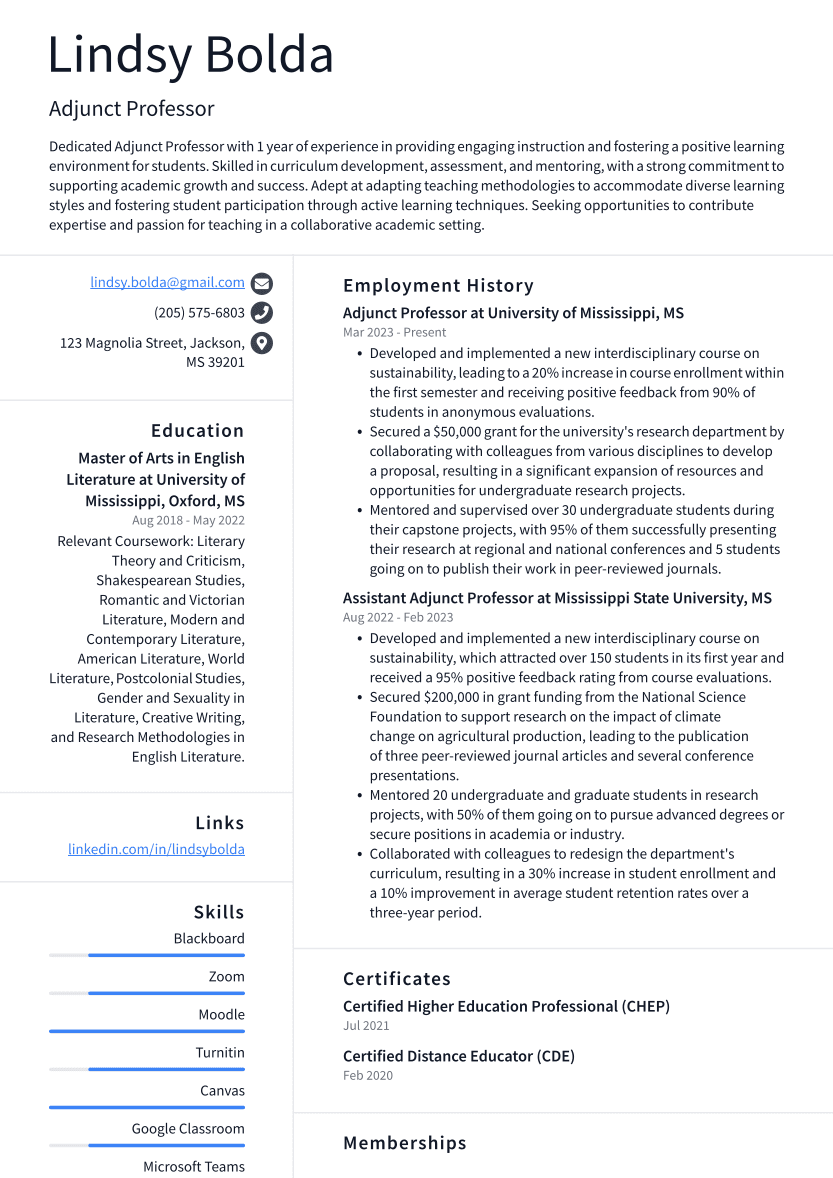Adjunct Professor Resume Examples
Writing a great adjunct professor resume is important because it is one of the first things a potential employer will see when they are considering you for a position. It is your opportunity to make a good first impression and sell yourself as the best candidate for the job.
Create your resume
Select from 7 professional resume templates
If you're looking for inspiration when it comes to drafting your own adjunct professor resume, look no further than the samples below. These resumes will help you highlight your experience and qualifications in the most effective way possible, giving you the best chance of landing the adjunct professor job you're after.
Essential Components of an Adjunct Professor's Resume
An effective resume is crucial for adjunct professors aiming to highlight their academic prowess, teaching experience, and professional competencies. A well-crafted resume for an adjunct professor should include key sections that illuminate the individual's qualifications, experiences, and skills pertinent to the position. This document plays a pivotal role in creating a positive initial impression on hiring committees and setting the stage for successful interviews. Below, we delve into the various sections of a resume, discussing the significance of each, what they should encompass, and tips for making them stand out.
1. Contact Information
Ensuring your contact information is prominently displayed and up-to-date is essential. This section should include your full name, address, phone number, and a professional email address. Refrain from using casual or unprofessional email addresses, as they can detract from your credibility.

Given the importance of digital presence, consider adding a LinkedIn profile link and, if applicable, a link to your online portfolio or personal website showcasing your academic work.
Tip: Ensure all contact details are legible and error-free to facilitate easy communication for hiring managers.
2. Professional Summary or Objective Statement
The Professional Summary or Objective Statement serves as a brief introduction to your resume, summarizing your professional background, teaching expertise, and career aspirations. Tailor this section to reflect your passion for education, mastery in your subject area, and notable accomplishments.
Align your statement with the job description, highlighting skills and experiences that address the employer's needs. This section should not only articulate what you bring to the role but also your ambitions within the position, such as curriculum development or fostering an engaging educational environment.
Related: Top Adjunct Professor Resume Objective Examples
3. Educational Background
Your educational background is a cornerstone of your resume, showcasing your academic credentials, which are fundamental for a role in higher education. List your degrees in reverse chronological order, including any honors or distinctions that underscore your academic dedication.
Include relevant certifications or professional development courses that enhance your qualifications, and briefly mention significant research or thesis work that aligns with your teaching interests.
Note: Accuracy is paramount; any discrepancies in your educational history could disqualify you from consideration.
4. Teaching Experience and Relevant Work History
The Teaching Experience and Relevant Work History sections are where you can showcase your instructional expertise and related professional experiences. Detail the courses you've taught, innovative teaching methods employed, and any relevant non-teaching roles that contribute to your subject matter expertise.
Highlight any accolades or achievements, such as high student success rates or scholarly publications. Remember to list experiences in reverse chronological order and provide specific dates to illustrate your career progression.
5. Research and Publications
The Research and Publications section is your opportunity to highlight scholarly contributions and ongoing research interests. Detail your research objectives, methodologies, outcomes, and any presentations or publications resulting from your work.
Include a comprehensive list of publications, providing titles, co-authors, publication venues, dates, and summaries. Links to online versions of your work can further substantiate your academic involvement.
6. Skills and Specializations
In the Skills and Specializations section, emphasize both hard and soft skills relevant to the adjunct professor role. Hard skills might include subject matter expertise and educational technology proficiency, while soft skills could encompass communication, adaptability, and leadership qualities.
Focus on skills that are directly applicable to the job at hand, and whenever possible, quantify your achievements to provide tangible evidence of your capabilities.
Related: Adjunct Professor Skills: Definition and Examples
7. Certifications and Professional Affiliations
The Certifications and Professional Affiliations section can set you apart by showcasing additional qualifications and your commitment to professional development. List relevant certifications and memberships in professional organizations, highlighting any active roles or contributions within these groups.
Focus on affiliations that are pertinent to the position you're applying for, as they reinforce your credibility and dedication to your field.
Related: Adjunct Professor Certifications
By carefully crafting each section of your resume, you can present a compelling narrative of your professional journey as an adjunct professor, positioning yourself as a strong candidate for the role.